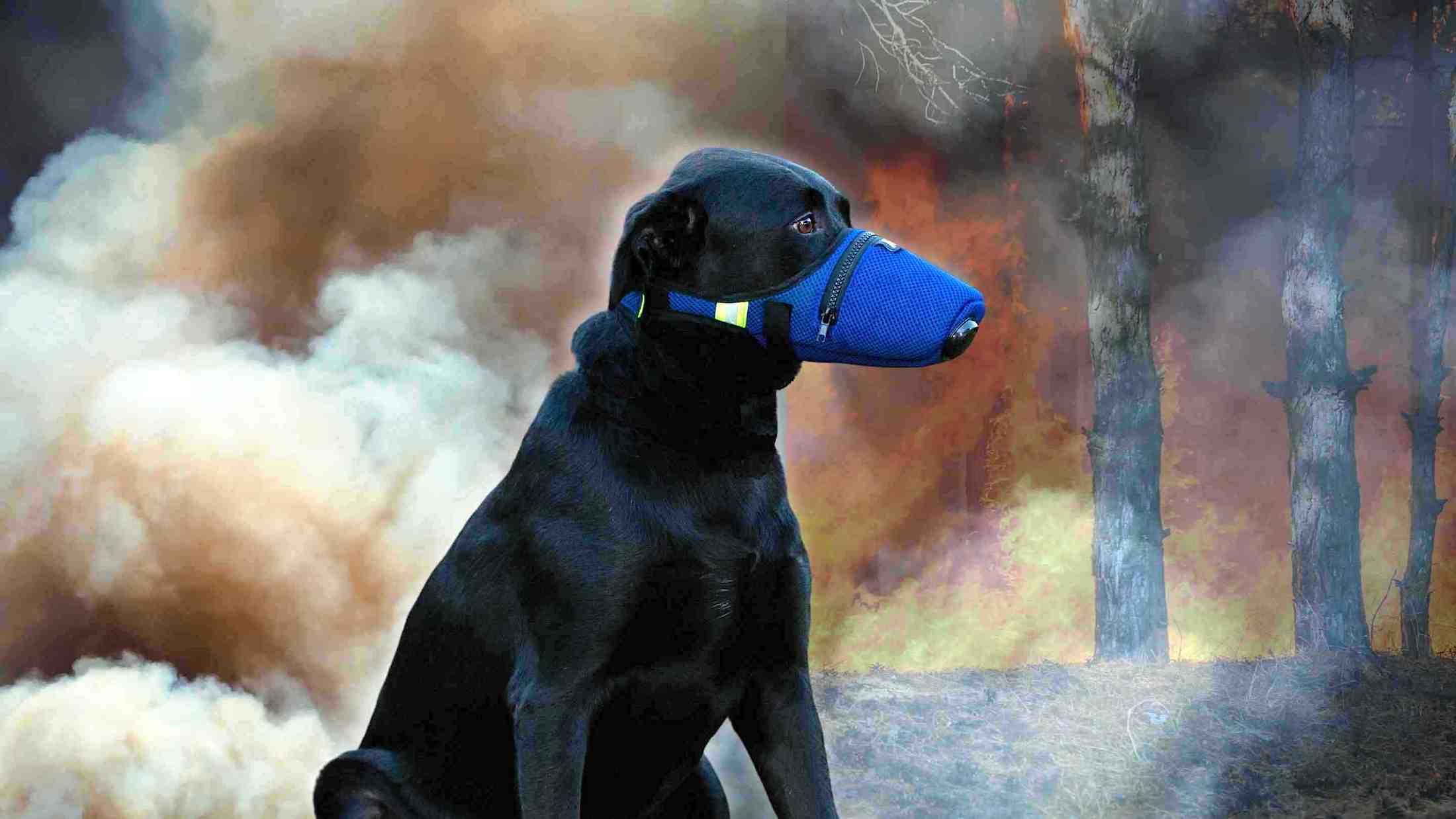K9 Mask® Air Filtration Test with ISO 16890 Results
The International Organization for Standardization (ISO) has introduced ISO 16890, a new standard for testing and classification of air filters. The norm was fully implemented worldwide in August 2018.

Performance Testing of Air Filters
The methods used for testing and classifying air filters are laboratory techniques. Test procedures involve a duct in which a filter is mounted in a controllable fan. A “test dust” is introduced upstream of the filter to challenge the unit and evaluate its performance. The test dust may be the particles already present in the ambient air, or it could be a laboratory prepared mixture of particles made to a “recipe” defined in the test standard.
Located upstream and downstream of the test filter are air samplers and particle counters. Particle counters are sensitive devices that count the number of airborne particles within a narrow size range. Using an array of counters, it is possible to simultaneously count a wide range of different sized particles. Comparing the particle counts upstream and downstream of the filter allows the efficiency of the filter to be determined for different size particles.
Test methods usually allow the efficiency of a filter to be determined in the “as-new” condition (clean) and also under conditions that simulate the changes anticipated during the working life of the filter.
Regulatory Background
Prior to the introduction of ISO 16890, there were two standards in common use: The EN779: 2012 predominated in Europe and the ASHRAE 52.2 predominated in the US. Both standards are used side by side in Asia. Both these established standards, however, have disadvantages, including:
- Neither had global applicability. This was a deficiency because many major building projects are engineered in one country, constructed in a second country by a contractor based in yet a third country.
- The test methods employed in EN 779 and ASHRAE 52.2 are fundamentally different. Thus is not possible to compare results from the two norms.
- The filter classification categories defined in the two standards say nothing about the actual real-world behavior of the filters, or what benefits users can realistically expect to achieve in terms of air quality, which is problematic for specifiers, purchasers and users of air filters. This is of special interest if there are sensitive objects or processes to be protected.
The test dust used in EN 779 and ASHRAE 52.2 is a poor representation of typical suspended particulate matter found in city-center ambient air. Test results do not necessarily represent filter performance in real-world applications.

The Ideal Filter Classification System
As a minimum, it seems reasonable that a filter classification system would provide clear information on the ability of a device to remove different size particles from the air that are relevant for individual customers. It would mean filters could be chosen and specified easily across borders.
The ISO 16890 is a significant harmonization for the air filtration industry. The key benefits for users of air filters include:
- An acknowledgement that air filters positively influence air quality and benefit health.
- Global applicability. One test and classification system to be utilized throughout the industry that can be readily understood by specifiers, purchasers and users of air filters.
- The ability to easily select and comprehend product value in relation to function and application.
Key Features of ISO 16890
Depending on achieved removal efficiency against different size particles, filters can be classified into one of four categories that relate directly to removal efficiency against PM1, PM2.5, PM10 and “coarse” particles; those larger than 10 microns.
The new standard establishes a minimum of 50% removal efficiency is required for inclusion in the three most demanding categories (very fine and medium particles); PM1, PM2.5 and PM10.
In consideration that some filters use an electrostatic charge applied to the filter media to temporarily enhance performance, the new ISO standard incorporates a discharge procedure that is part of the test. The discharge method eliminates the errors caused by short term or temporary effects.
Under the new standard, a minimum of 50% removal efficiency after the discharge procedure is required for inclusion in all the categories (very fine or medium particles).
It is recognized that the electrostatic charge applied to the filter media may be effective when the filter is new. However, in real-world applications, any such electric charge is dissipated over a period of days or weeks, and the performance of the filter deteriorates very significantly from the “as new” value.
For PM1, PM2.5 and PM10 classifications, the reported efficiency (expressed in percentage] is the average value of the initial efficiency and the discharged efficiency values. As stated above, by the new standard both values must exceed 50%.

Key Definitions
Particulate matter is commonly defined in terms of physical size, usually expressed in microns. For example, each cubic meter of city center air contains many millions of suspended particles. They range in size from below 0.1 micron (nanoparticles) up to 100 microns.
Most particles, however, are smaller than 1 micron, and there are few particles greater than 25 microns that, due to their weight, are suspended.
Very fine particles mostly originate from combustion processes, principally vehicle engines, while larger particles originate from different sources including construction and nature; pollen, sand and, soil.
The level of particulate matter is being monitored and reported by dedicated website around the world. The traditional reporting categories are PM2.5 (particles < 2.5 microns) and PM10 (particles < 10 microns).
These are normally reported as a weight value with units of μg/m3 (micrograms per cubic meter). Increasingly, attention is shifting to even smaller particles as these are known to penetrate far deeper into the human body reaching critical organs such as the brain, heart and liver.
Today, the scientific interest is focused on PM1 (particles smaller than 1 micron) or ultra-fine particles (particles smaller than 0.5 microns).
Moreover, the norm ensures no sudden efficiency drop after discharge as was possible with older filter types, because the new rigorous test type means efficiency must be capable of being maintained over the filter lifetime.

K9 Mask® ISO 16890 Filtration Test Results
K9 Mask® dog air filters have been certified by Blue Heaven Technologies in Louisville, Kentucky, USA with an ISO 16890 Air Filter Test for the Extreme Breathe (XTRM) and Clean Breathe (CLN) air filters.
This is a summary of the test results for these two air filters:
Extreme Breathe XTRM N95 Active Carbon Air Filter
- ✅ for PM2.5 effectiveness.
- View full K9 Mask® Extreme Breathe air filter laboratory certified results
| Particulate Size (PM in microns) | Initial Efficiency % | Discharged Efficiency % |
| 0.3-0.4 | 99% | 42% |
| 0.4-0.55 | 99% | 53% |
| 0.55-0.7 | 99% | 63% |
| 0.7-1.0 | 99% | 73% |
| 1.0-1.3 | 99% | 84% |
| 1.3-1.6 | 100% | 90% |
| 1.6-2.0 | 100% | 95% |
| 2.0-3.0 | 100% | 99% |
| 3.0-4.0 | 100% | 100% |
| 4.0-5.5 | 100% | 100% |
| 5.5-7.0 | 100% | 100% |
| 7.0-10.0 | 100% | 100% |
Clean Breathe PM10+ Active Carbon Air Filter
- ✅ for PM10 effectiveness.
- View full K9 Mask® Clean Breathe air filter laboratory certified results
| Particulate Size (PM in microns) | Initial Efficiency % | Discharged Efficiency % |
| 0.3-0.4 | 1% | 2% |
| 0.4-0.55 | 2% | 2% |
| 0.55-0.7 | 2% | 3% |
| 0.7-1.0 | 3% | 3% |
| 1.0-1.3 | 4% | 3% |
| 1.3-1.6 | 5% | 5% |
| 1.6-2.0 | 7% | 7% |
| 2.0-3.0 | 12% | 12% |
| 3.0-4.0 | 23% | 22% |
| 4.0-5.5 | 41% | 40% |
| 5.5-7.0 | 61% | 59% |
| 7.0-10.0 | 74% | 69% |
Contact us for more details about the ISO 16890 test results.






